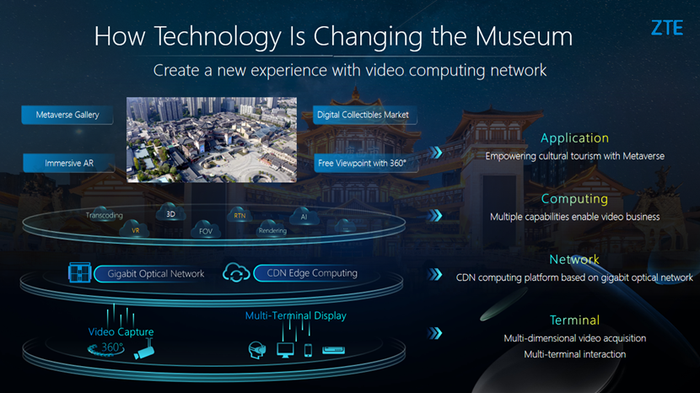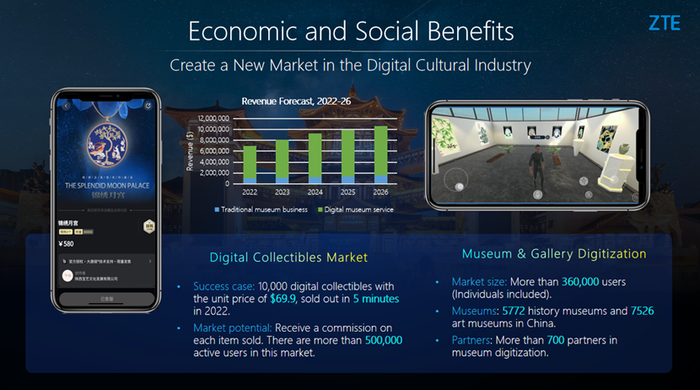ZTE 5G VR Solution Brings the Culture of Tang Dynasty to LifeZTE 5G VR Solution Brings the Culture of Tang Dynasty to Life
September 14, 2023

Metaverse has gradually gained acceptance in recent years. Industries build their own independent metaverse spaces respectively, which forms a discrete, multi-centered ecosystem, with AR, VR and immersive display technologies as the current technical foundation. Nowadays, metaverse is usually adopted in information services, culture and entertainment industries, particularly widely used in museums. Many museums tend to create a digital twin in metaverse for visitors to experience exhibitions whenever and wherever they want, thus bringing more traffic to museums.
Under such a background, ZTE has developed the digital museum solution. With online tours of cultural relics and exhibitions powered by 5G and VR, ZTE provides users with a brand new experience that spans time and space, soothing people’s regret of not being able to witness the flourishing Tang culture in person. As an innovative metaverse application, digital museum will lead to a significant change, reshaping the museum industry and creating more possibilities.
Tang West Market Museum, focusing on the culture of Tang and Silk Road and built on the original site of the West Market in Chang’an city of the Tang Dynasty (618-907), has been an important window to present the glorious history and civilization of Xi’an (known as Chang’an in ancient times). To help the museum embrace digital transformation, ZTE teamed up with China Mobile and other business partners to build 5G and cloud-based infrastructures, and provide 6 major capability platforms, including a Big Video platform, metaverse engine, Virtual Reality (VR) platform, Extended Reality (XR) platform, AI Engine (AIE), and Tulip Elastic Cloud System (TECS). These platforms can greatly meet customers’ various service needs, enable online museum exhibitions, and create avatars as museum guides.

The cultural and artworks metaverse platform delivers a brand new user experience, allowing culture and museum enthusiasts to experience the Tang Dynasty culture in an immersive way without leaving home. Based on this, the cultural industry has gradually transformed from traditional to digital through online integration, achieving modular expansion. On the one hand, it promotes the exhibition and interactive service development of digital artifacts and cultural artworks. Backed up with technologies such as 5G, XR, video cloud computing, and virtual set-top box (vSTB), a platform for exhibition and interaction can be built to facilitate the expansion from physical to digital applications, enabling metaverse museum, metaverse art gallery, 5G digital cultural park, and more. It also provides services such as building digital artifacts, creating 5G online digital museum, and experiencing cultural relics, digital landscape and tour guiding. Apart from promoting the growth of digital museum services, the solution can also help the cultural tourism industry reach a much wider audience and thus boost consumption. On the other hand, it drives the growth in online and offline trading of digital artifacts and cultural artworks. Leveraging technologies like 5G, blockchain and cloud computing, an art trading platform can be created to facilitate the online exhibition and trading of artworks, thus materializing the tangible presentation and circulation of digital cultural assets.

Moving forward, the goal of digital museum is to build a digital silk road, enabling full integration and application of core technologies such as cloud computing, big data, artificial intelligence, blockchain, and 5G communication. With blockchains from all over the world linked together, a multinational platform for the registration, exchange, trading, and circulation of cultural artworks can be formed, featuring a wide variety of languages, categories, and currencies. The platform can be used for the release and trading of digital and physical artworks and intellectual property, and provide related financial services. It is expected to promote the convergence of digital assets, stimulate innovation in new economic sectors, and flourish a large market for international artwork trading, thus promoting the joint development of cultural industry and digital economy.
About the Author
You May Also Like











.png?width=300&auto=webp&quality=80&disable=upscale)


_1.jpg?width=300&auto=webp&quality=80&disable=upscale)